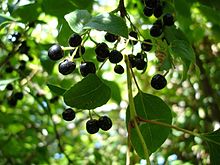- Aristotelia chilensis
-
Maqui 
Maqui Tree with fruits Scientific classification Kingdom: Plantae (unranked): Angiosperms (unranked): Eudicots (unranked): Rosids Order: Oxalidales Family: Elaeocarpaceae Genus: Aristotelia Species: A. chilensis Binomial name Aristotelia chilensis
(Molina) StuntzSynonyms - Cornus chilensis Molina
- Aristotelia macqui L'Hér.
Aristotelia chilensis (Maqui or Chilean Wineberry) is a species of the Elaeocarpaceae family native to the Valdivian temperate rainforests of Chile and adjacent regions of southern Argentina.[citation needed]
Contents
Description
It is a small dioecious tree reaching 4-5 m in height, evergreen, and with a divided trunk with smooth bark. Its branches are abundant, thin and flexible. Its leaves are simple, opposite, pendulous, oval-lanceolate, with serrated edges, glabrous, coriaceous with venation and strong red petioles.[citation needed] Its flower is small and white, yielding a small edible fruit (maqui berry) that is a favored food for birds.[citation needed] The small, purple-black berries are approximately 4-6 mm in diameter. The maqui berry is also known as the Chilean wineberry, and locally as maqui or maquei, queldrón, ach, koelon, and clon.[citation needed]
Polyphenols
Only limited polyphenol research has been completed on the maqui berry showing its anthocyanin content includes eight glucoside pigments of delphinidin and cyanidin, the principal anthocyanin being delphinidin 3-sambubioside-5-glucoside (34% of total anthocyanins).[1] The average total anthocyanin content was 138 mg per 100 g of fresh fruit (212 mg per 100g of dry fruit),[1] placing maqui low among berries for anthocyanin content (see Anthocyanins#Occurrence for tabulated content data).
Anthocyanins are also present in maqui leaves.[2]
Uses
According to myths, the edible fruit was eaten by the Mapuche.[citation needed] Claude Gay documented in 1844 that natives used maqui to prepare chicha as may have been referenced in his "Physical Atlas of History and Politics of Chile".[citation needed] Today, maqui may be used to make jam, juice, an astringent or as an ingredient in processed foods or beverages.[citation needed] It has been planted in Spain.[3]
References
- ^ a b Escribano-Bailón MT, Alcalde-Eon C, Muñoz O, Rivas-Gonzalo JC, Santos-Buelga C (2006). "Anthocyanins in berries of Maqui (Aristotelia chilensis (Mol.) Stuntz)". Phytochem Anal 17 (1: Jan-Feb): 8–14. PMID 16454470.
- ^ Suwalsky M, Vargas P, Avello M, Villena F, Sotomayor CP (Nov 2008). "Human erythrocytes are affected in vitro by flavonoids of Aristotelia chilensis (Maqui) leaves". Int J Pharm 363 (1-2): 85–90. PMID 18687390.
- ^ "Chilean plants cultivated in Spain". José Manuel Sánchez de Lorenzo-Cáceres. http://www.arrakis.es/~jmanuel/Plantaschilenas.pdf. Retrieved 2010-07-16.
External links
Categories:- Elaeocarpaceae
- Trees of Chile
- Plants of mild maritime climate
- Berries
Wikimedia Foundation. 2010.
